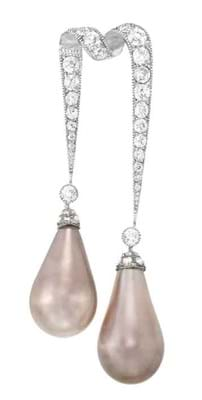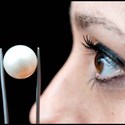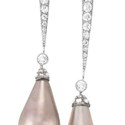Doyle New York sold a pair of rare and exceptional natural pearls for $2.8m/£1.74m ($3,301,000 including buyer's premium) - an auction record for a pair of natural pearls, beating the SFr2m (then £1.43m) taken at Christie's in Geneva on May 15, 2013 for a pair of natural pearl and diamond ear pendants, weighing approx 261.66 and 216.37 grains.
The Swiss Gemmological Institute or SSEF, recognised as the world's leading gemmologists/pearl testers, had used remarkably enthusiastic language when describing the two large drop-shaped pearls mounted as a platinum-and-diamond pendant c.1920 which carried an estimate of $100,000-200,000 for the same on April 28..
"Assembling a matching pair of natural pearls of this size and quality is very rare and exceptional, and thus this pair of pearls can be considered a very exceptional treasure of nature," concluded the report. They formed a near-perfect pair in shape, size, colour and weights (calculated at approximately 104 and 100 grains).
A handwritten note accompanying the pendant associated the pearls with Empress Eugenie, whose jewels were sold at an historic auction in the Louvre in 1887, following the fall of Napoleon III. Tiffany & Co. was the largest purchaser at that 12-day sale, buying almost a third of the French crown jewels.
The note adds that they later descended in the families of two prominent industrialists of America's Gilded Age - George Crocker (1856-1909) whose father founded the Central Pacific Railroad, and Henry Huttleston Rogers (1840-1909) who made a fortune as a partner in Standard Oil. His granddaughter Anne Rogers Benjamin wore the pearls at her debut in 1941 in the ballroom of New York's St Regis Hotel, later bequeathing them to her daughter Mrs Lewis A. Shea, who was Doyle's consignor.
Single Round Pearl
Salisbury's Woolley & Wallis, who set one of the best prices ever for a pair of pearl earrings (£1.4m on April 26, 2012 for a pair of more than 130 grains each) offered what was dubbed "the largest round natural saltwater pearl offered at auction" just three days later on May 1.
It was early this year that jewellery department head Jonathan Edwards was shown a pair of pearl earrings - one of which he suspected might be a natural saltwater pearl.
X-rays in London confirmed his hunch and, after dispatch to Geneva, the SSEF report, dated February 5, 2014 read: "The described natural pearl exhibits an impressive size and weight of 33.147 carats (132.59 grains), combined with an attractive roundish shape and smooth pearl lustre. The pearl shows an attractive white colour with weak rosé and green overtones, poetically also referred to as the 'orient of pearls'. A natural pearl of such a large size and quality is very rare and exceptional."
A gem such as this would have been produced by a gold lip oyster (pinctada maxima) and would have taken the lifetime of the mollusc (perhaps at least ten years) to develop, probably in the warm waters of the Australian South Seas or Venezuela/Panama waters.
Research continues into the suggestion that this was the largest round natural saltwater pearl ever offered at auction. There are historical records of larger spherical pearls - an inventory of the French crown jewels completed shortly before the Garde Meuble was stormed in 1792 had listed a 388 grain, round pearl, while a pearl of 148 grains was referred to in Jean-Baptiste Tavernier's Voyages (1676-79) as being a gift to the Great Mogul from Shah Abbas II, King of Persia.
Woolley & Wallis estimated the pearl at £80,000-120,000, but huge interest from the international trade prior to the sale suggested this sum could be exceeded many times.
So it proved. When W&W chairman Paul Viney opened the bidding at £30,000, one phone bidder immediately leapt to ten times that figure. The bidding rose from there as a battle between the phones until the hammer came down at £680,000, with the pearl selling to international jewellery dealership David Morris.
The total for the sale was £1.6m.









